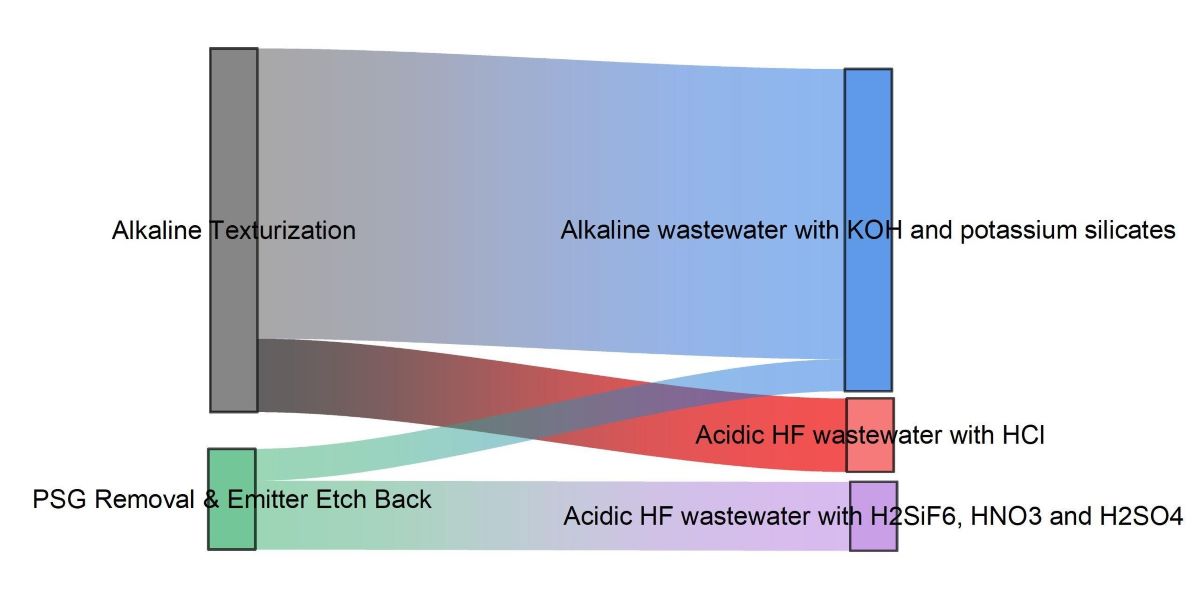Researchers from Germany's Fraunhofer Institute for Solar Energy Systems (Fraunhofer ISE) developed models to assess and compare two circular water strategies in a 5 GW passivated emitter and rear (PERC) solar cell factory.
They claim it is the first published “comprehensive water model” for a solar cell factory.
The team compared two freshwater and wastewater flow scenarios with a water strategy at a conventional PERC cell manufacturing plant. The first scenario, known as low contaminated wastewater (LCR), reclaims rinsing waters so that they can be indirectly discharged in line with regulations. “Additionally, certain wastewater streams were used as fresh water for downstream applications,” said the researchers.
The second scenario, known as minimal liquid discharge (MLD), reduces the wastewater amount leaving the factory as much as possible, while identifying and retrieving possible valuables from the wastewater, according to the team.
For each scenario, a cost-benefit analysis and life cycle assessment (LCA) were conducted using Umberto 11 software, which is commonly used to analyze the environmental impacts of companies and products, and the life cycle inventory Ecoinvent database. The analysis also relied on a specific material flow model, environmental assessment, and total cost ownership (TCO) calculations.
“An overall environmental impact analysis is required to determine if the proposed solutions achieve a net environmental improvement for the solar cells production system,” stated the team. “The results show that for the investigated scenarios 38% and 79% of the water consumption and 40% and 84% of the wastewater indirect discharge at the cell factory can be saved by the LCR and MLD approaches, respectively.”
Furthermore, cost reductions of 0.5% and 0.7% from cell production were identified for LCR and MLD strategies, respectively. “Compared to the reference scenario, the proposed circular water strategies offer significant water and wastewater savings,” said the group.
Several types of water and wastewater handling technologies were considered, keeping in mind costs, energy demand, operational risks and complexity. Only water recycling technologies commercially available and specifically suited for the chemical characteristics of PV wastewater were considered, such as reverse osmosis, calcium fluoride precipitation, and ultrafiltration technologies.
The team also gathered extensive data for each of the production steps of PERC solar cells. Other relevant constraints included a throughput of 2819 m2 cells per hour, and products with the following characteristics: 160 µm thickness, 244.32 cm2, 5.37 W, and 22% cell power conversion efficiency.
Several tools were used to build the scenario models. For mixing of streams, evaporation, precipitation and neutralization reactions and usage of chemicals, the team used the phreeqc software, which is a computer program for speciation, batch-reaction, one-dimensional transport, and inverse geochemical calculations. Solutions for the evaporation processes were modeled with the SIT.dat database for high-saline solutions. Membrane processes were simulated with DuPont WAVE water treatment design software. Water and wastewater stream models, including water reclamation processes, were also demonstrated.
As for the life cycle impact assessment (LCIA), the EU Environmental Footprint, Version 3.0 was used, and an improvement on the environmental impact single score of the cell production was achieved. It decreased by 0.4% for LCR and 3.2% for MLD.
“The performed lifecycle costs analysis has shown that such technologies are economically viable for this application, but energy, water and wastewater discharge prices had to be carefully assessed,” said the academics, adding that net cell production cost reductions of €0.025/W and €0.035/W are achievable for the LCR and MDL strategies, respectively.
“Reductions in environmental impact on the cell factory are estimated from -1.4% to 34.3% for the different impact categories, with significant reductions in the freshwater ecotoxicity, freshwater and marine eutrophication for both circular water strategies,” explained the team.
The researchers provided a capital expenditure (CAPEX) and operating expenditures (OPEX) for each of the two circular water strategies, noting that the LCR overall energy consumption is “relatively low” with a “very low CAPEX and OPEX” case. They also observed that, compared to the reference case, no resource recovery other than water is achieved.
In their analysis of the MLD scenario, they noted it required high thermal energy and greater CAPEX and OPEX for the required machinery. Having said that, they noted MLD enables freshwater reduction of 79%, and wastewater reduction of 84%, resulting in annual savings in freshwater and wastewater costs, as well as the opportunity to recover “valuable by-products” for use in other industries.
Looking ahead, the researchers see adoption in tunnel oxide passivated contact (TOPCON) and heterojunction (HJT) factories as “many of the wastewater streams analyzed are similar.” A demonstrator setup is recommended, “to validate the estimated savings as many technical challenges had to be overcome.”
The novel water circulation concept was presented in the study “Circular water strategies in solar cells manufacturing,” published in Solar Energy. The study was a collaboration of researchers from Fraunhofer ISE, RENA Technologies GmbH, Technische Universität Berlin, and the Fraunhofer Institute for Building Physics.
This content is protected by copyright and may not be reused. If you want to cooperate with us and would like to reuse some of our content, please contact: editors@pv-magazine.com.



By submitting this form you agree to pv magazine using your data for the purposes of publishing your comment.
Your personal data will only be disclosed or otherwise transmitted to third parties for the purposes of spam filtering or if this is necessary for technical maintenance of the website. Any other transfer to third parties will not take place unless this is justified on the basis of applicable data protection regulations or if pv magazine is legally obliged to do so.
You may revoke this consent at any time with effect for the future, in which case your personal data will be deleted immediately. Otherwise, your data will be deleted if pv magazine has processed your request or the purpose of data storage is fulfilled.
Further information on data privacy can be found in our Data Protection Policy.